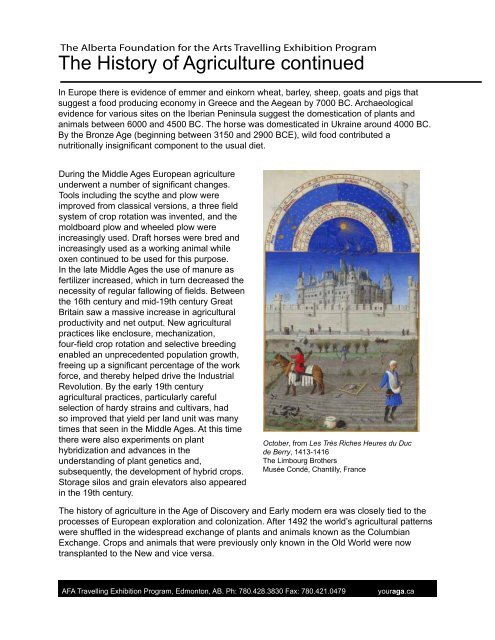Down on the Farm - Art Gallery of Alberta
Down on the Farm - Art Gallery of Alberta
Down on the Farm - Art Gallery of Alberta
- No tags were found...
You also want an ePaper? Increase the reach of your titles
YUMPU automatically turns print PDFs into web optimized ePapers that Google loves.
The <strong>Alberta</strong> Foundati<strong>on</strong> for <strong>the</strong> <strong>Art</strong>s Travelling Exhibiti<strong>on</strong> ProgramThe History <strong>of</strong> Agriculture c<strong>on</strong>tinuedIn Europe <strong>the</strong>re is evidence <strong>of</strong> emmer and einkorn wheat, barley, sheep, goats and pigs thatsuggest a food producing ec<strong>on</strong>omy in Greece and <strong>the</strong> Aegean by 7000 BC. Archaeologicalevidence for various sites <strong>on</strong> <strong>the</strong> Iberian Peninsula suggest <strong>the</strong> domesticati<strong>on</strong> <strong>of</strong> plants andanimals between 6000 and 4500 BC. The horse was domesticated in Ukraine around 4000 BC.By <strong>the</strong> Br<strong>on</strong>ze Age (beginning between 3150 and 2900 BCE), wild food c<strong>on</strong>tributed anutriti<strong>on</strong>ally insignificant comp<strong>on</strong>ent to <strong>the</strong> usual diet.During <strong>the</strong> Middle Ages European agricultureunderwent a number <strong>of</strong> significant changes.Tools including <strong>the</strong> scy<strong>the</strong> and plow wereimproved from classical versi<strong>on</strong>s, a three fieldsystem <strong>of</strong> crop rotati<strong>on</strong> was invented, and <strong>the</strong>moldboard plow and wheeled plow wereincreasingly used. Draft horses were bred andincreasingly used as a working animal whileoxen c<strong>on</strong>tinued to be used for this purpose.In <strong>the</strong> late Middle Ages <strong>the</strong> use <strong>of</strong> manure asfertilizer increased, which in turn decreased <strong>the</strong>necessity <strong>of</strong> regular fallowing <strong>of</strong> fields. Between<strong>the</strong> 16th century and mid-19th century GreatBritain saw a massive increase in agriculturalproductivity and net output. New agriculturalpractices like enclosure, mechanizati<strong>on</strong>,four-field crop rotati<strong>on</strong> and selective breedingenabled an unprecedented populati<strong>on</strong> growth,freeing up a significant percentage <strong>of</strong> <strong>the</strong> workforce, and <strong>the</strong>reby helped drive <strong>the</strong> IndustrialRevoluti<strong>on</strong>. By <strong>the</strong> early 19th centuryagricultural practices, particularly carefulselecti<strong>on</strong> <strong>of</strong> hardy strains and cultivars, hadso improved that yield per land unit was manytimes that seen in <strong>the</strong> Middle Ages. At this time<strong>the</strong>re were also experiments <strong>on</strong> planthybridizati<strong>on</strong> and advances in <strong>the</strong>understanding <strong>of</strong> plant genetics and,subsequently, <strong>the</strong> development <strong>of</strong> hybrid crops.Storage silos and grain elevators also appearedin <strong>the</strong> 19th century.October, from Les Très Riches Heures du Ducde Berry, 1413-1416The Limbourg Bro<strong>the</strong>rsMusée C<strong>on</strong>dé, Chantilly, FranceThe history <strong>of</strong> agriculture in <strong>the</strong> Age <strong>of</strong> Discovery and Early modern era was closely tied to <strong>the</strong>processes <strong>of</strong> European explorati<strong>on</strong> and col<strong>on</strong>izati<strong>on</strong>. After 1492 <strong>the</strong> world’s agricultural patternswere shuffled in <strong>the</strong> widespread exchange <strong>of</strong> plants and animals known as <strong>the</strong> ColumbianExchange. Crops and animals that were previously <strong>on</strong>ly known in <strong>the</strong> Old World were nowtransplanted to <strong>the</strong> New and vice versa.AFA Travelling Exhibiti<strong>on</strong> Program, Edm<strong>on</strong>t<strong>on</strong>, AB. Ph: 780.428.3830 Fax: 780.421.0479youraga.ca
















